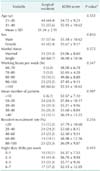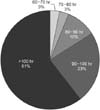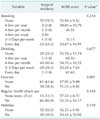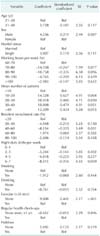Abstract
Purpose
The application rate for surgical residents in Korea has continuously decreased over the past few years. The demanding workload and the occupational stress of surgical training are likely causes of this problem. The aim of this study was to investigate occupational stress and its related factors in Korean surgical residents.
Methods
With the support of the Korean Surgical Society, we conducted an electronic survey of Korean surgical residents related to occupational stress. We used the Korean Occupational Stress Scale (KOSS) to measure occupational stress. We analyzed the data focused on the stress level and the factors associated with occupational stress.
Results
The mean KOSS score of the surgical residents was 55.39, which was significantly higher than that of practicing surgeons (48.16, P < 0.001) and the average score of specialized professionals (46.03, P < 0.001). Exercise was the only factor found to be significantly associated with KOSS score (P = 0.001) in univariate analysis. However, in multiple linear regression analysis, the mean number of assigned patients, resident occupation rate and exercise were all significantly associated with KOSS score.
Surgery plays a crucial role in modern medical treatment. The importance of well-qualified surgeons cannot be over-emphasized; however, little attention has been paid in recent times to the quality of training programs for surgical residents in Korea. These days, surgical residents have a heavier workload and experience more stress due to the labor force shortage, which has been caused in part by a decrease in the rate of applicants and an increased workload in systematized hospitals [1]. Moreover, the dropout rate for surgical residents during training is also increasing. This overworking of surgical residents leads to a vicious cycle, with the application rate for surgical residency continuously decreasing year by year. The decrease in the number of applicants and the high dropout rate of surgical residents has become a serious social issue in Korea. Many things may cause these problems, but one of the important reasons is the excessive workload and high occupational stress these surgical residents are put under [2].
Occupational stress has a positive effect when it encourages individuals to maintain an appropriate level of tension and increases the efficiency of work [3]. On the other hand, the excessive occupational stress that surgeons are under might not only threaten job satisfaction, but also increases medical errors [4]. Previous studies have reported that that extreme stress leads to burnout of surgical residents, which can contribute to impaired technical performance, medical errors, and physical and mental health problems, and may even increase the risk of suicide [56].
In other countries, a number of studies have reported the high level of stress and reduced job satisfaction of residents [789]. However, this is the first study to investigate the occupational stress and burnout of surgical residents in Korea. The aim was to evaluate the level of the occupational stress and related factors experienced by the entire surgical resident population in Korea.
With the support of the Korean Surgical Society, we conducted an electronic survey of Korean surgeons, including surgical residents, in October 2012. The e-mail addresses of all surgeons were provided by the Korean Surgical Society. The cover letter of the e-mail sent to surgeons stated the purpose of this survey, participation was completely voluntary and all responses were anonymous. The study was commissioned by the Korean Surgical Society and overseen by the Institutional Review Board of Korea University Anam Hospital.
Sixty-five questions were used to assess the demographics, characteristics and the level of stress using the full version of the Korean Occupational Stress Scale (KOSS) (Supplementary material), which was validated by the National Study for Development and Standardization of Occupational Stress in Korea [10]. The survey used in this study includes a subscale of the Maslach Burnout Inventory which uses two items to measure whether a participant is burnt out or not [11], and additional questions to assess their lifestyle variables, working conditions, stress reactions/coping strategies and job satisfaction.
Internal consistency was calculated using Cronbach alpha. KOSS score is expressed as mean ± standard deviation. To compare the stress score of surgical residents with that of other specialized professions, we used the previous reported KOSS scores from a study conducted by the Korean Occupational Safety and Health Agency in 2005 [12]. The comparisons of mean KOSS scores between groups were performed using the Student t-test and one-way variance of analysis, followed by Tukey post hoc test. To find out the most reliable factors affected by occupational stress, multiple linear regression analysis was performed. In this study, a P-value <0.05 was interpreted as statistically significant. All statistical analyses were performed using IBM SPSS Statistics ver. 20.0 (IBM Co., Armonk, NY, USA).
All surgeons who were members of the Korean Surgical Society, including surgical residents were eligible for participation in this survey. Of the 4,294 surgeons who were surveyed, 621 (14.5%) participate in this study. Of the 651 surgical residents registered as members of the Korean Surgical Society, 99 surgical residents responded the survey. Therefore, the response rate of the surgical residents was 15.1% (99/651). We analyzed the data of these surgical residents based on variable factors such as working conditions and lifestyle characteristics. The mean age was 31.3 years old. Of these 99 residents, 57 (57.6%) were men and 42 (42.4%) were women.
Table 1 shows comparisons between the KOSS scores of surgical residents and those of practicing surgeons and other specialized professions. A mean KOSS score for a surgical resident was 55.39 ± 9.98, which was significantly higher than that of the practicing surgeons (48.16 ± 9.53) and the average KOSS score of other specialized professionals (46.03) [13]. Notably, The KOSS score of surgical residents showed statistically significant differences compared to the practicing surgeons in all subscales including the total KOSS score.
In order to elucidate the factors affecting occupational stress, KOSS score was analyzed with demographic factors and practice characteristics. However, working hours per week, mean number of assigned patients, resident recruitment rate, and number of night shifts per week were not significantly related to the occupational stress of responding surgical residents (Table 2). In terms of lifestyle characteristics, regular exercise was significantly associated with lower KOSS score (P = 0.001) (Table 3).
However, when we performed multiple linear regression analysis for KOSS including all variables, such as demographics, practice characteristics and lifestyle characteristics, the mean number of assigned patients, resident recruitment rate and exercise were all significantly associated with KOSS score (Table 4).
The distribution of working hours for surgical residents is shown in Fig. 1. More than 90% of the surgical residents surveyed work more than 80 hours per week. The respondents were divided into two groups; one group consisted of surgeons who work less than 80 hours a week and the other group consisted of surgeons working more than 80 hours a week. The KOSSs of these groups were compared with one another and there was no significant difference between the two groups in mean KOSS score or any of the subscales (Fig. 2).
Burnout and career satisfaction were also analyzed. More than half of the surgical residents reported that they had experienced burnout (66.7%), which was significantly higher than the practicing surgeons (25.1%) (P = 0.002). Moreover, more than half of the surgical residents (53.5%) included in their survey response that, given the opportunity to go back, they would not again choose to become a surgeon. Eighty-four percent of surgical residents answered that they would not recommend this career to their children (Table 5).
Despite the fact that the application rate for surgical residents has steadily declined in recent years in Korea, no other reports have investigated the workload of surgical residents and the factors associated with the decline in numbers of surgical residents. This study focused on occupational stress and related factors in surgical residents.
Not surprisingly, the mean KOSS score of a surgical resident is significantly higher than that of other specialized occupations. Furthermore, surgical residents showed significantly higher mean scores in almost all subscales when compared to individuals with other specialized occupations, except in terms of relationship conflicts and job instability. One intriguing fact is that the subscale of "lack of reward" was still high for surgical residents, despite recent increases in pay for surgical trainees. This increase in the cost of the surgeons' labor is a temporary national policy to support the attrition of surgical residents [1]. This finding suggests that the increased labor cost may not be enough to offset the high demands upon surgical residents. Alternatively, this finding may indicate that this is not an effective policy to overcome the attrition of surgical residents. According to our previous study, Korean surgeons are under more stress due to the lack of reward than people with other specialized jobs [13]. Therefore, a strategy must be developed to make up for this lack of reward, based on deep consideration of the surgeons' workload.
Based on this study, it appears that most surgical residents suffer from long working hours. More than ninety percent of the residents are working over 80 hours per week. Furthermore, sixty-one percent of the residents work more than 100 hours per week. Veasey at al. [14] reported that sleep loss and fatigue of residents can negatively affect the outcome of their patients. Shanafelt et al. [15] analyzed 7,900 members of the American College of Surgeons and reported that the number of hours worked and nights on call per week appear to have a substantial impact on surgeons' stress. Our previous study also showed that long working hours were related to higher occupational stress levels of surgeons [13]. Korean surgical residents work many more hours than average employees. For example, based on one survey reported in 2008, over 40% of residents work more than 18 hours per day, which is extraordinarily high [116]. This problem has been raised and discussed among residency program directors and government officers, and as a result, the Ministry of Health and Welfare decided to implement a new policy restricting working hours to a maximum of 80 hours per week for training residents to prevent overwork. Many studies that have been conducted overseas reported that an 80-hour work week policy affected neither patients' outcomes nor residents' education [171819]. Therefore, we divided surgical residents into two groups on the basis of this working hour limitation (<80 hours per week) and investigated the differences in the level of occupational stress (KOSS) between the two groups. Contrary to our expectation, there was no significant difference in KOSS score between groups who worked less than 80 hours and more than 80 hours per week. This finding is probably related to the small sample size of residents working less than 80 hours; only six percent of residents worked less than 80 hours per week. This may also explain the lack of significant differences seen when we analyzed KOSS according to working hours. Therefore, it is necessary to reinvestigate the relationship between working hours and the other factors associated with occupational stress when the restriction policy on resident working hours has been put into effect.
On the other hand, in the multiple linear regression analysis, the mean number of patients, and the resident recruitment rate were all significantly associated with KOSS score. These results suggest that the attrition of surgical residents has led to an increased workload on each surgeon, and has also caused increased occupational stress. Our previous study of Korean surgeons also showed that frequent night shifts, a higher mean number of patients, and long working hours were all positively correlated with higher KOSS [13]. In addition, we identified unusually long working hours and uncontrolled overworking of surgical residents. Almost half of the surgical residents surveyed (48.5%) reported working night shifts more than 4 days a week. Surprisingly, 17% of residents have 6 or 7 night shifts per week. Even residents who are not assigned night shifts are likely to be overworked, as 61% of residents work more than 100 hours per week. Therefore, it is necessary to improve the working conditions of surgical residents.
Among lifestyle variables, exercise was significantly associated with low levels of occupational stress. Many reports have been published on the positive effects of exercise [202122]. Shanafelt et al. [20] conducted a cross-sectional survey of 7,197 American surgeons in 2010. In this study, aerobic exercise was found to be an important independent factor for avoiding burnout and maintaining high quality of life. Another study of 209 practicing transplant surgeons revealed that exercise played a role in reducing the level of emotional exhaustion, which can be a component of burnout [21]. As our results also show, regular exercise is an important factor in the effective reduction of occupational stress. Therefore, it is important to pay attention to the welfare of surgical residents and to provide the time and facilities to encourage regular exercise.
Burnout is a widely used tool to measure the occupational stress of medical workers [23]. In our study, sixty-six percent of surgical residents experienced burnout, which is remarkably high compared to burnout rate in practicing surgeons (25.1%, P = 0.002). In our previous study, it was revealed that the experience of burnout was significantly associated with high KOSS [13]. This high burnout rate is a dangerous sign because it can adversely affect the mental health of surgical residents and lead to medical errors [5]. As shown in Table 4, 49.5% of surgical residents surveyed replied that they would not become a physician if they were to make the choice again, and this answer was also significantly more common than in practicing surgeons. This result reflects a lower level of career satisfaction in surgical residents.
The limitations of this study included the relatively low response rate compared to other surveys. However, this is the first large-scale survey to measure occupational stress and its related factors among surgical residents. Our study used KOSS score as a standardized occupational stress scale, which enabled us to compare occupational stress of surgeons with people of other occupational groups in Korea. Moreover, this study provided crucial information on the current status of surgical residents in terms of occupational stress and working environments.
In conclusion, surgical residents have a higher occupational stress level compared to both practicing surgeons and individuals working in other specialized professions. The mean number of patients, resident recruitment rate, and exercise were all significantly related to the occupational stress levels of Korean surgical residents. Resident program directors and associated staff should place particular emphasis on the welfare of surgical residents, and make a commitment to the improvement of surgical residents' working environments.
Figures and Tables
Fig. 2
Comparison of Korean Occupational Stress Scale (KOSS) score according to working hours, with surgeons divided into two groups on the basis of an 80-hour work week.

Table 1
Comparison of KOSS scores of surgical residents with specialized professionals and practicing surgeons

Table 2
Demographic and practice characteristics and KOSS score of the responding Korean surgical residents

ACKNOWLEDGEMENTS
Funds received from the Korean Surgical Society were used to cover the administrative costs of performing the survey, data entry, and statistical analysis.
References
1. Kim JH, Jung SS, Lee IK, Song BJ, Moon JH, Jang YS, et al. Status and prospect of workforce requirement for surgery in republic of Korea. J Korean Surg Soc. 2011; 81:363–373.
2. Kim SK. How to save surgical residents in crisis. J Korean Surg Soc. 2009; 76:207–214.
3. Selye H. The stress of life. New York: McGraw-Hill Book Co.;1956.
4. Newbury-Birch D, Kamali F. Psychological stress, anxiety, depression, job satisfaction, and personality characteristics in preregistration house officers. Postgrad Med J. 2001; 77:109–111.
5. West CP, Tan AD, Habermann TM, Sloan JA, Shanafelt TD. Association of resident fatigue and distress with perceived medical errors. JAMA. 2009; 302:1294–1300.
6. Balch CM, Freischlag JA, Shanafelt TD. Stress and burnout among surgeons: understanding and managing the syndrome and avoiding the adverse consequences. Arch Surg. 2009; 144:371–376.
7. Harms BA, Heise CP, Gould JC, Starling JR. A 25-year single institution analysis of health, practice, and fate of general surgeons. Ann Surg. 2005; 242:520–526.
8. Yeo H, Viola K, Berg D, Lin Z, Nunez-Smith M, Cammann C, et al. Attitudes, training experiences, and professional expectations of US general surgery residents: a national survey. JAMA. 2009; 302:1301–1308.
9. Weinstein DF. Duty hours for resident physicians: tough choices for teaching hospitals. N Engl J Med. 2002; 347:1275–1278.
10. Chang SJ, Koh SB, Kang D, Kim SA, Kang MG, Lee CG, et al. Developing an Occupational Stress Scale for Korean employees. Korean J Occup Environ Med. 2005; 17:297–317.
11. Maslach C, Jackson SE, Leiter MP. Maslach burnout inventory. Evaluating stress: a book of resources. London: The Scarecrow Press Inc.;1997. p. 191–218.
12. Cho JJ, Kim JY, Chang SJ, Fiedler N, Koh SB, Crabtree BF, et al. Occupational stress and depression in Korean employees. Int Arch Occup Environ Health. 2008; 82:47–57.
13. Kang SH, Boo YJ, Lee JS, Han HJ, Jung CW, Kim CS. High occupational stress and low career satisfaction of Korean surgeons. J Korean Med Sci. 2015; 30:133–139.
14. Veasey S, Rosen R, Barzansky B, Rosen I, Owens J. Sleep loss and fatigue in residency training: a reappraisal. JAMA. 2002; 288:1116–1124.
15. Shanafelt TD, Balch CM, Bechamps GJ, Russell T, Dyrbye L, Satele D, et al. Burnout and career satisfaction among American surgeons. Ann Surg. 2009; 250:463–471.
16. Yoo MW, Lee IK, Ahn HS, Kim JW, Lee HJ, Lee KU, et al. Survey of the residency training program in surgery. J Korean Surg Soc. 2008; 74:1–9.
17. Morrison CA, Wyatt MM, Carrick MM. Impact of the 80-hour work week on mortality and morbidity in trauma patients: an analysis of the National Trauma Data Bank. J Surg Res. 2009; 154:157–162.
18. Durkin ET, McDonald R, Munoz A, Mahvi D. The impact of work hour restrictions on surgical resident education. J Surg Educ. 2008; 65:54–60.
19. de Virgilio C, Yaghoubian A, Lewis RJ, Stabile BE, Putnam BA. The 80-hour resident workweek does not adversely affect patient outcomes or resident education. Curr Surg. 2006; 63:435–439.
20. Shanafelt TD, Oreskovich MR, Dyrbye LN, Satele DV, Hanks JB, Sloan JA, et al. Avoiding burnout: the personal health habits and wellness practices of US surgeons. Ann Surg. 2012; 255:625–633.
21. Bertges Yost W, Eshelman A, Raoufi M, Abouljoud MS. A national study of burnout among American transplant surgeons. Transplant Proc. 2005; 37:1399–1401.
22. Bittner JG 4th, Khan Z, Babu M, Hamed O. Stress, burnout, and maladaptive coping: strategies for surgeon well-being. Bull Am Coll Surg. 2011; 96:17–22.
23. Maslach C. Job burnout new directions in research and intervention. Curr Dir Psychol Sci. 2003; 12:189–192.
SUPPLEMENTARY MATERIAL
Supplementary material can be found via http://astr.or.kr/src/sm/astr-89-268-s001.pdf.




 PDF
PDF ePub
ePub Citation
Citation Print
Print






 XML Download
XML Download